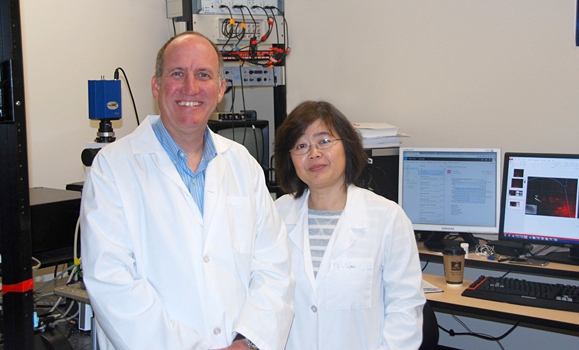Neuroscience researchers at Dalhousie Medical School and the Brain Repair Center in Canada have found a way to bypass the nervous system to stimulate muscles that have lost their connection to the nervous system through injury or disease.
Dr. Victor Rafuse, professor in the Department of Medical Neuroscience and director of the Brain Repair Centre, and his collaborator, Dr. Ying Zhang, an assistant professor in the same department, have shown they can stimulate the muscles directly with light, to address muscle-wasting and paralysis caused by nerve injuries and neurodegenerative diseases.
 |
|
Dr. Victor Rafuse and Ying Zhang are part of the Dalhousie team that discovered a light-activated pathway to restore muscle function. (Photo courtesy of Dalhousie Medical School) |
Dalhousie surgery resident and PhD candidate Dr. Philippe Magown, and masters student Dr. Basavaraj Shettar, worked with Drs. Rafuse and Zhang on the groundbreaking project. Their findings were published in the prominent scientific journal, Nature Communications, on October 13.
“We’ve found we can prevent atrophy in completely dennervated muscles by shining light on them through the skin for an hour a day,” says Dr. Rafuse. “Others have used light to successfully stimulate nerves, but we are the first to bypass the nerves and go straight to the muscles. This is vital, because the nerve tissue is completely destroyed in many injuries and in diseases like ALS, so you can’t rely on stimulating nerves to activate muscles.”
A light-activated pathway to restoring function
To test their theory that light could be used to activate muscles directly, the researchers used mouse genetics to insert a light-activated ion channel — first discovered in the single-celled aquatic organism, Chlamydomonas reinhardtii — into a line of mice. This enabled their muscles to contract when stimulated with blue LED light.
“Our next step is to develop a means of delivering the light-activated ion channel directly to the muscles, without altering the genome,” Dr. Rafuse says. “Then we would have a viable therapeutic strategy for human use.”
For example, Dr. Rafuse suggests that the gene encoding the channel could be delivered into hand muscles of a person with a peripheral nerve injury that has severed the nervous system’s connection to the hand. “We see the possibility of developing a ‘light glove’ they could wear to prevent atrophy in those muscles and use to stimulate muscle contractions whenever they want to grasp something.”
This developing technology has many potential uses, including the ability to stimulate the diaphragm in people with ALS who are suffering from respiratory problems due to the loss of the motor neurons and synaptic connections that innervate their breathing muscles.












